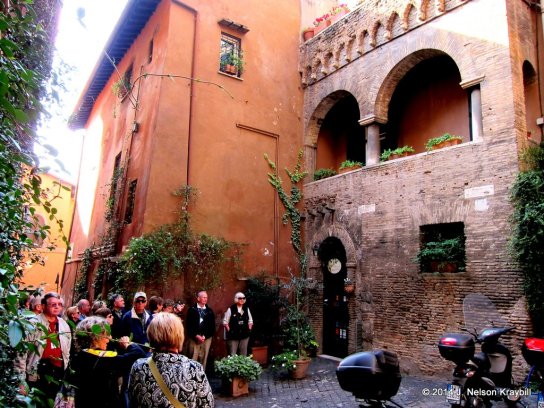When we came into Rome, Paul was allowed to live by himself, with the soldier who was guarding him. Three days later he called together the local leaders of the Jews. . . He lived there two whole years at his own expense and welcomed all who came to him, proclaiming the kingdom of God and teaching about the Lord Jesus Christ . . . Acts 28:16–17, 30–31

Paul, ambassador of the early Christian movement, was passionate about taking good news of reconciliation in Jesus Christ to Rome, capital of the empire that crucified his Lord. The apostle yearned to show God’s love to everyone from slave to emperor. Along with Peter and many others, Paul apparently died a martyr at Rome. Ponte Fabricio (“Bridge of Fabricius”) across the River Tiber is a place to ponder how and where Paul might have spent his last years.
The book of Acts states that Paul, after arriving at Rome as a prisoner awaiting trial, continued his ministry under house arrest. Only one soldier guarded him, suggesting the imperial government did not consider him a danger. Paul arrived in Rome about AD 60, and may have lived among Jews in Trastevere (Tras-TAY-very, “across the Tiber”). This was the primary Jewish quarter of first-century Rome, a working class neighborhood directly across the river from the heart of the city.

Trastevere was a harbor and warehouse area for boats coming up the Tiber from the seaport at Ostia. The district teemed with sailors, porters, shopkeepers, and craftsmen. Millers ground wheat arriving from Egypt, and the stench of leather tanning filled the air.
Years earlier, still thinking that he first would visit Rome as a free man, Paul wrote that faith of the church there was “proclaimed throughout the world” (Rom. 1:8). Paul hoped to visit the imperial capital and let that church send him on for witness in Spain (Rom. 15:28–29). Instead, he got charged with disturbing the peace when he visited Jerusalem, and came to Rome a prisoner.
Regardless of exactly where Paul resided under house arrest in Rome, Ponte Fabricio would have been a pedestrian and vehicle artery connecting him with fellow Jews. The name Lucius Fabricius, Roman commissioner who built the bridge in 62 BC, still is legible on the side of the structure. Made of stone, Ponte Fabricio survived the great fire of AD 64, when much of the city fell to flames.
Suspected of having torched the city himself, Emperor Nero accused Christians of arson. Tacitus (AD 117), says an “immense multitude was convicted,” and many suffered cruel death at orders of the emperor. It is likely that both Peter and Paul died in this short spate of severe local persecution.

Several of the oldest (fourth-century) archeological sites of early churches in Rome are in Trastevere, and the façade of a tenth-century synagogue survives. These show that despite occasional harassment or persecution, Jews and Christians remained a significant presence in that part of the ancient capital. To them and to all who would listen, Paul wrote, “I am not ashamed of the gospel; it is the power of God for salvation . . . to the Jew first, and also to the Greek” (Rom. 1:16).
Confident that God would unite and restore all things in Christ, Paul ministered in urban hubs where the gospel could have maximum impact.
© 2015 J. Nelson Kraybill ****************************************************
Please enter your email address in the designated box at the edge of this webpage if you have not already subscribed, and click Follow. You’ll get a notice every three or four weeks when I put up a new blog post.
If you want to see Jordan, Israel, and Palestine, join a Peace-Pilgrim bible study tour this fall, see Holy Land (Jordan, Israel & Palestine) with Pastor Nelson Kraybill – November 5-16, 2015.
For a tour in 2016, see https://tourmagination.com/tours/by-date/2016-tours/498-jordan-palestine-israel-a-journey-of-hope
See my book on Christians and Jews in the Roman empire at http://www.amazon.com/Apocalypse-Allegiance-Politics-Devotion-Revelation/dp/1587432617/ref=sr_1_1?ie=UTF8&qid=1425912158&sr=8-1&keywords=apocalypse+and+allegiance
Yes! That Paul was the man who was capturing Christians and delivering them up to death sentences until God got a hold of him. That is why I not only pray for persecuted Christians in Nigeria but also for the perpetrators. Perhaps there is a “Paul” among them that God can use. Dorothy Horst
LikeLike
Nelson
I remember well crossing the bridge into Trastevere and standing in front of the synagogue and trying to put my brain around the fact that they existed in the first century.
It was good to see you in Harrisburg and blessings to you as you continue your work with MWC.
Warm regards,
Audrey Voth Petkau
TourMagination
9 Willow Street, Waterloo, ON N2J 1V6
Tel: 519-885-2522 Fax: 519-885-0941 Toll free: 1-800-565-0451
http://www.tourmagination.com apetkau@tourmagination.com
[cid:459442517@12062012-2742]
LikeLike